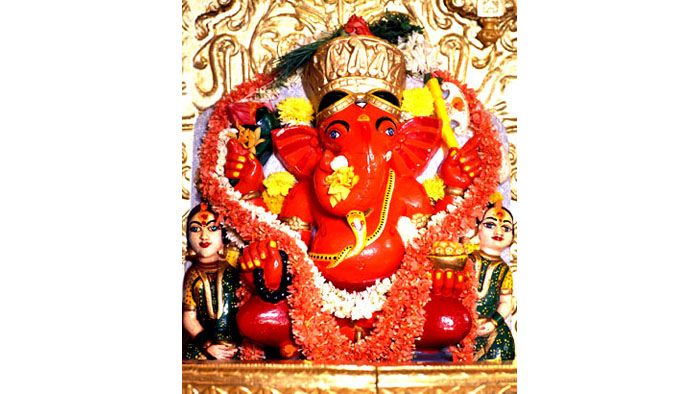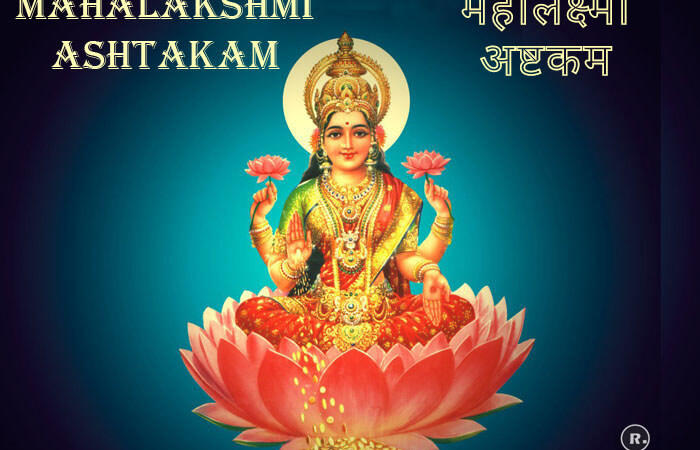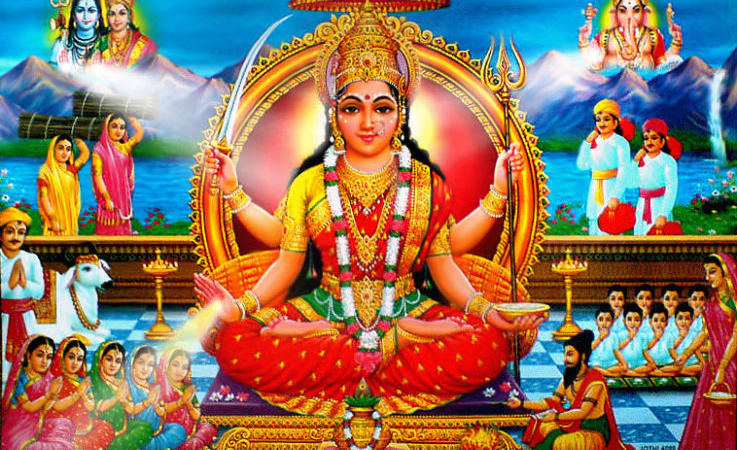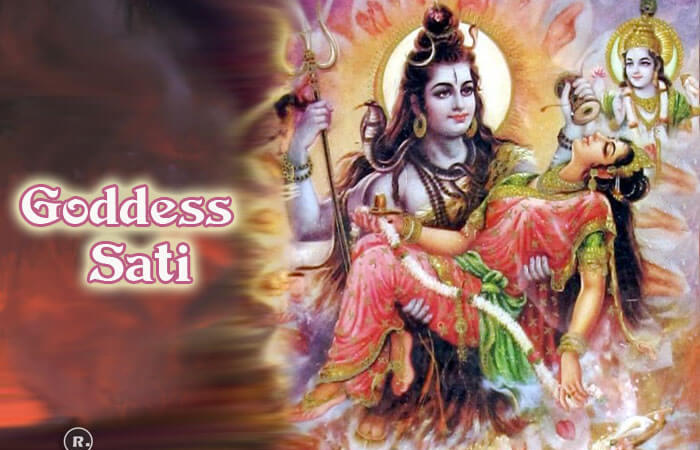Siddhivinayak Temple, Mumbai

Siddhivinayak Temple or Shree Siddhivinayak Ganapati Mandir is a Hindu temple dedicated to Lord Shri Ganesh, it is located near Kakasaheb Gadgil Marg and S.K. Bole Marg in Prabhadevi, Mumbai, Maharashtra.
It is one of the most famous temples and one of the richest temples in Mumbai. The wooden doors to the sanctum are carved with images of the Ashtavinayak (the eight manifestations of Ganesha). The inner roof of the sanctum is plated with gold.
About Siddhivinayak Temple
The old temple was consecrated on Thursday, 19th November 1801. According to our Hindu Calendar, it falls on Kartik Shudha Chaturdashi, Shake 1723 in “Durmukh Sanvatsar”. Its build-up area was 3.60mtr. x 3.60mtr. square. It was a ground floor structure, it had 450mm thick brick walls and an old type dome, again of brick with a Kalash above. Around the dome, a parapet wall with grills was the structure of the temple. The floor level of the temple and road level was also the same.
This temple is on the corner of Kakasaheb Gadgil Marg and S.K.Bole Marg in Prabhadevi, which is facing heavy vehicular traffic It was built by a professional contractor, Late Mr.Laxman Vithu Patil as per the financial support and instructions of Late Mrs.Deubai Patil, who was a rich lady of Agri Samaj from Matunga. Although she was rich enough, she had no child.
The idea of the construction of the temple struck Late Deubai during the prayer time, she humbly requested Lord Ganesh and said, “Although I cannot have a child, let other ladies who are childless get the pleasure of child on visiting the temple and praying you”.
Looking at the successful subsequent history of the temple, it appears as Lord Ganesh nodded to this humble request and pious thoughts and deeds of Late Deubai Patil. It is, therefore, this Siddhivinayak is famous for it and known as “Navasacha Ganapati” or “Navasala Pavanara Ganapati” in Marathi (Ganapati bestows whenever humbly genuinely prayed a wish) among devotees.
The idol of Shree Siddhivinayak was carved out of a single black stone and is 2’6″ (750mm) high and 2′ (600mm) wide with the trunk on the right. This is rather an unusual appearance of Lord Ganesh. The upper right and left hands hold a lotus and an ax respectively while the lower right and left hands hold a rosary (japmala) and a bowl full of “Modak” respectively. As it resembles the sacred thread, a snake appears on the left shoulder to right side belly. On the forehead of the deity is an eye, which almost looks like the third eye of Lord Shiva. On both sides of the Lord Ganesh idol, are placed one idol each of Riddhi and Siddhi goddesses who are appearing like peeping out of the Ganesh idol from behind. Because of these two deities along with Lord Ganesh, this temple is known as the Siddhivinayak Ganapati Temple. These goddesses signify sanctity, success, wealth, and prosperity.
Around 125 years ago, Shri Akkalkot Swami Samarth’s great disciple, Late Ramakrishna Jambhekar Maharaj, who was also an ardent devotee of Lord Ganesh and Gayatri Mantra was blessed with Assyssinian ( Siddhi ). One day Swami Samarth asked Shri Jambhekar to bring divine idols. Out of the idols, except two idols, Swami Samarth told to bury in the front courtyard of the house of Swami Samarth’s another disciple Shri Cholappa, where Swami Samarth used to temporarily reside. Shri Jambhekar was also told to inhume the remaining two idols in front of Lord Ganesh that he usually worshipped. During his attendance with Swami Samarth, Shri Jambhekar foretold that a Mandaar tree would grow on the place after 21 years, Swayambhu ( Swayambhu ) Ganesh would appear in the sacred place. From that onward people’s devotion would grow in leaps and beyond.
After a few years, Jambhekar Maharaj whose Math is near the sea-shore at Dadar, Mumbai, asked Late Priest Govind Chintaman Phatak to look after, perform regular religious pooja, etc. of Shree Siddhivinayak Temple. The predecessor of Priest Phatak, there was Late Namdev Kelkar performing priest-wood job in the temple.
From the available information and records, the land of the temple complex was around 2550 sq. meters. There was a lake towards the eastern and southern side of the temple admeasuring approx. 30 x 40 sq. meters. This lake was built by Nardulla in the early 19th century, to overcome the scarcity of water, faced by the area. The lake was, later on, filled up, and now it is a playground and a part of Kakasaheb Gadgil Marg.
There was also a rest house, sought of Dharmashala, and a pair of beautiful 3.6 in high, stone masonry “Deepmalas”. There was also a dwelling unit for the owner of this complex. In the earlier days when there were not many structures of the residential and commercial type in its neighborhood area. The devotees in large numbers started visiting the temple only after 1952 and the long-standing Q’s were seen in 1965 onwards.
Since the owner had divided the original plot and subleased it to different parties and naturally the space available around this old temple reduced and became quite small. After 1975, the number of devotees visiting the temple started growing by a real sense of Geometrical Progression. It became difficult to enter the temple or even to have “Darshan” of Lord Ganesh, the devotees were finding it quite troublesome to enter through the two small doors
How to Reach Shri Siddhivinayak Temple
By Road
Shri Siddhivinayak Temple is just a 60 to 90 minutes drive away from the Domestic or International Airport, depending on the traffic scenario. It is on the way to South Mumbai’s business district. After entering the city at Bandra, one must go towards Worli. Then the road will take you through Mahim, Shivaji Park, Dadar Portuguese Church onto Prabhadevi and that is the place where the Temple is located. If you take some other direction, you have to drive down from Tardeo or Kemps Corner towards Prabhadevi passing by Haji Ali, Shivsagar Estate, Worli Naka, and Century Bazar. Most locals and taxi drivers can help you with the location of this very renowned Temple and be getting directions is usually not an issue.
By Train
Dadar is the nearest railway station on both the Western and Central Suburban Railway. From Dadar railway station it is a 10 minutes ride by car or taxi and most of the taxi drivers know the route to the temple. For those tourists who are willing to take the bus, there are several bus routes that pass by the Temple and it is a ride of about 15 minutes. The Temple can be also reached from the Western Suburban Railway stations of Lower Parel, Elephinston Road, and Mahalaxmi.
Best Time to Visit
Being a seaside city, Mumbai’s temperature is quite reminiscent of any tropical country. With soaring temperatures in the summer, disastrous amounts of rain, and virtually no winter to speak of, Mumbai is a humid city, with predictable temperatures.
June – July:
Considered to be the best time to pay the city a visit, particularly if you’re not accustomed to the heat. The months of June and July bring the monsoon with it, ensuring some regulation of the otherwise soaring temperatures. Deemed as one of the best cities to visit during the monsoon, Mumbai in the rains is one phenomenon everyone must witness.
December – February:
For what it’s worth, winter comes to Mumbai between the months of December and February. It’s not as bone-chilling as the other parts of the country, but for those who are used to year-round heat, the winter could prompt you to put on a sweater.
March-May:
If there’s ever a time to avoid Mumbai like the plague, it’s between the months of March & May. This is summer with a vengeance. If you’re coming from a cold place or any place that follows the cycle of the seasons, Mumbai will take time to get used to it.
Things to know before entering the temple premise
-
Temple has high security so avoid carrying metal, sharp things inside the temple.
-
Spitting, smoking is prohibited inside the temple.
-
If you are thinking to buy anything inside the temple like Prasad, flowers, photos of Ganesha then take care. It is possible that the shopkeeper will give you less quality taking full money.
-
Don’t carry any valuable things inside the temple.
-
Photography is prohibited inside the temple
Siddhivinayak Temple schedule
Timing from Wednesday to Monday
| Time | Event |
| 5.30-6.30 | kakad aarti |
| 6.00-12.15 | shree darshan |
| 12.15-12.30 | naivedya |
| 12.30 – 19.30 | shree darshan |
| 19.30-20.00 | aarti |
| 20.00-21.50 | shree darshan |
| 21.50 | shejaarti, temple door closed. |
Timings on Tuesday (day of Lord Ganesha)
| Time | Event |
| 3.15-4.45 | shree darshan |
| 5.30-6.30 | kakad aarti |
| 6.00-12.15 | shree darshan |
| 12.15-12.30 | naivedya |
| 12.30 – 19.30 | shree darshan |
| 19.30-20.00 | aarti |
| 20.00-21.50 | shree darshan |
| 21.50 | shejaarti, temple door closed. |






